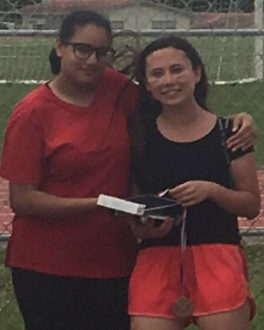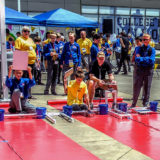February 27, 2018

John Gouldman, 8th Grade Science Teacher
Over the past year, I’ve introduced challenges to my students that help them grow, both as scientists and as creative thinkers. Sure, my eighth graders learn about physics and earth science. But through their participation in STEM competitions, students also learn how to persevere, how to work together and how to go back to the drawing board. They learn concrete science skills, but they also use what we often call “soft skills” – like communication and critical thinking – that they will use every day for the rest of their lives.
Last year, my science classes – all four of them – started participating in Junior Solar Sprint, in an effort to make my earth science and physics units more accessible and hands-on. Junior Solar Sprint is a STEM competition, offered by the U.S. Army Education Outreach Program in partnership with the Technology Student Association. The program gives students an opportunity to engage with engineering principals and scientific research methods in new and exciting ways while designing, building and racing solar powered cars. Throughout three months of preparation, students figure out how to develop their vehicles in ways that are wildly creative. It’s true, you can look at the exercise as a race that the students will either win or lose. But it’s really about the hard work and perseverance these students invest in their machines. Students tinker with these cars for months, and most of the time they come out with something that they’re proud of. At the beginning, some students feel like they’re just in it for the grade, but once they’ve seen their car cross the finish line for the first time – or not – they think more creatively and become more invested.
I’ve also found that the long-term nature of the project allows students to learn as much as possible from the exercise. Last year, I had a student with special needs who loved testing new things, but who needed more time to understand the physics behind what he was creating. Despite some setbacks, he ultimately discovered – for himself – that reducing the weight of the vehicle increases its top speed. That was a huge discovery for him, and I could feel his excitement and the new energy he brought to his build.
Many of my students “get it” late, but that’s part of why this exercise is valuable. More often than not, these students are motivated by the discoveries they wish they had tried out when they had the chance. That’s why I spread out the timelines and due dates to make sure students get to experiment with as many approaches as possible.
It’s valuable to learn how to put something down and pick it back up – both in Junior Solar Sprint and in life. Through this program, my students have learned to build for durability and not to give up when something breaks or doesn’t perform the way they thought it would. Last year, I got to watch my students grow through their projects and all the work that they put in. To me, the focus they bring to their work is how we ultimately measure success.


Junior Solar Sprint (JSS)
Junior Solar Sprint (JSS) is a competition for middle school students to create the fastest, most interesting and best crafted solar-vehicle possible.
More About Junior Solar Sprint (JSS)Find a Volunteering Opportunity
Visit our Program Volunteers page for a tool to find the best opportunity for you.
eCYBERMISSION Mini-Grant
The eCYBERMISSION Mini-Grant is intended to support teachers/program leaders as they implement eCYBERMISSION with their teams. Educators (formal and informal) of students in grades 6-9 are encouraged to apply.
